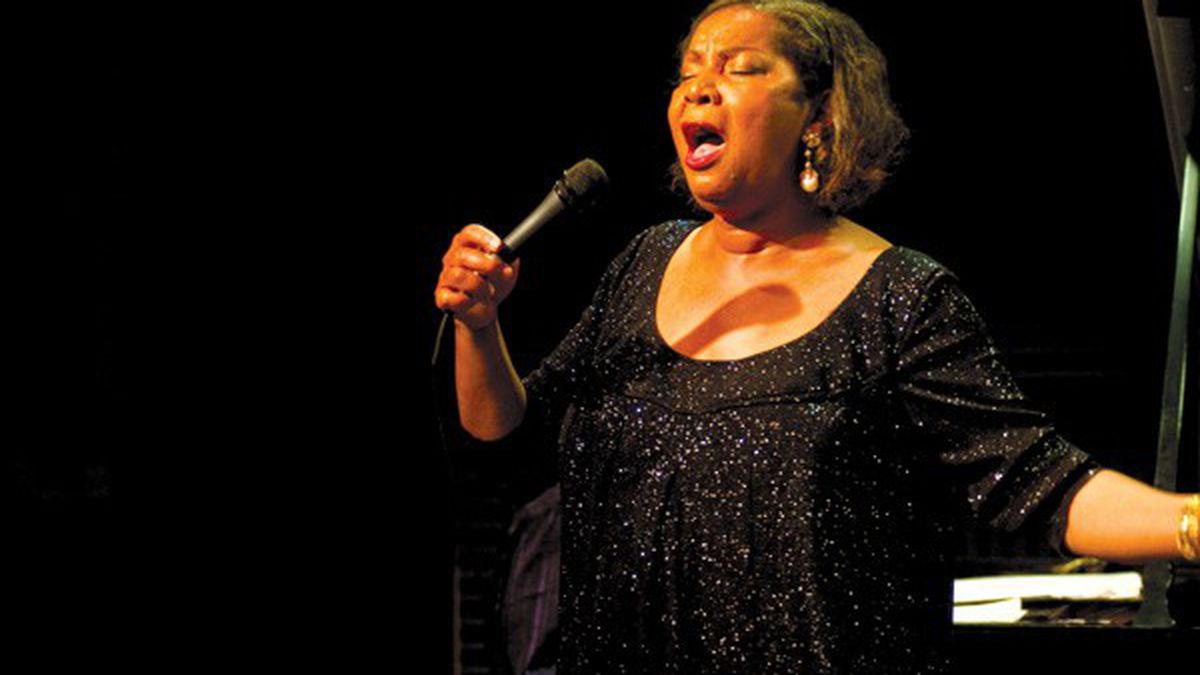Stephanie Crawford, perhaps the best little-known jazz vocalist in the Bay Area, recognized early in life that she has a knack for memorizing songs — every lyric, every subtle shift of melodic contour.And her pitch is about as perfect as it can get.
Take, for instance, the exquisite rendition of the 1953 Bob Dorough composition “Devil May Care” that she recorded in Paris in the early-1990s, before Diana Krall and Jamie Cullum gave the tune new currency. With only Riccardo Del Fra‘s upright bass as a harmonic safety net, Crawford maneuvers the register-shifting melody with near-flawless intonation. Within the space of a single phrase she moves from a ringing alto to a dusky contralto while projecting the words with crystalline diction.
The song is the lead track of The Real Thing, a thirteen-tune compilation of material from two CDs she recorded during her eight-and-a-half years in France. Crawford sells the disc, which has no booklet notes or musician and songwriter credits, at her local engagements, although those have become increasingly infrequent since Anna’s Jazz Island closed a year ago this month. She will, however, be performing this Friday at The Jazzschool, backed by pianist Larry Steelman, bassist Michael Jones, and drummer Paul Tillman Smith. She also has been teaching part-time at the school since a job as a Safeway grocery store wine steward brought her to the Bay Area five years ago.
“If I didn’t get the gig at the Jazzschool, I’d have no gigs at all,” she said in her North Oakland apartment, her dark eyes peering intensely over a pair of reading glasses perched on the tip of her nose. Piles of sheet music and songbooks, an electric piano on which she works out arrangements, and an easel for doing drawings and watercolors make her living room seem smaller than it is. One wall is covered with dozens of photographs, many clipped from magazines, of some of her heroes and heroines. They include Louis Armstrong, Betty Carter, Billie Holiday, B.B. King, Marilyn Monroe, Charlie Parker, and Tupac Shakur. A wood-and-bass Buddhist altar sits on a table against another wall.
“I don’t go out much at night,” she added. “Anna’s is closed. There’s very little nightclub scene in Oakland. Even if you drive a car, we don’t live in a time that’s safe. At night I really want to come home and listen for some music and watch reruns of The Golden Girls.”
Crawford was born 68 years ago in Detroit and divided her childhood between living with her mother in that city’s Black Bottom — so named not for its racial composition, but due to its dark soil — and with an aunt in Chattanooga, Tennessee. She was surrounded, especially in Detroit, by jazz, blues, R&B, and gospel music, and she draws little distinction between those subgenres of African-American music.
“It was all really one music,” she stated. “There’s only one second that separates Saturday night midnight and Sunday morning. In fact, the people who played on Saturday night were the same people who got up and played in church the following morning. The blues singer understood the minister, and the preacher understood the blues singer. It was all the same kind of expression. It was all black music.
“I distinctly recall my aunt playing ‘After Hours’ on the piano and then playing ‘Clair de Lune’ by Debussy. It was kind of a synthesis, if you will. It was the music coming out of the church, out of the bar, out of the whore house. It was the music that was played in the street. It wasn’t something that had to be acquired. It was right there.”
Crawford can’t remember a time when she didn’t sing. “If you took me to the movies and there was music in it and you brought me back, I would sing the music I heard,” she explained. She did not, however, sing in public until she was 36, after working on a Chrysler assembly line and as a short-order cook, and earning a bachelor’s degree in painting from Wayne State University.
Her first performance in front of an audience was at “an awful little dive” in Detroit. “There was a white lady who played piano on Sundays,” Crawford recalled. “She played rather badly. She’d forget the words, and I would call up the right words. One night she said, ‘Since you know the goddamn song, come up here and sing it.’ And she said, ‘Whenever you feel like singing, girlie, come on back.’ I was there the next week, and I never stopped going. I had found it.”
Later, in New York, while working on a master’s in fine arts, Crawford became so immersed in the Manhattan jazz scene that she dropped out of school in order to devote more time to sitting in at jam sessions. She also studied for a period with jazz greats Frank Foster and Barry Harris.
“I didn’t want to create a work of art,” she explained. “I wanted to be a work of art.”
Singing, she added, “is a compulsion. It is almost as if you are possessed. It allows you to communicate your innermost feelings and thoughts to others.”
During her days in Paris, she won the prestigious Django d’Or award for “Best International Jazz Vocalist” in 1993, but she earned her living more from teaching jazz singing at two music schools than from performing in clubs. After leaving France, she returned to New York to work for an importer of Portuguese wines, which led to her present job at Safeway.
Crawford’s compulsion to sing has never abated, even though she failed to find great success at it. “I’ve always sung from time to time,” she said. “I never became famous. I doubt that I shall ever become famous. You have to have particularly good fortune to achieve fame. It’s not synonymous with talent.”












